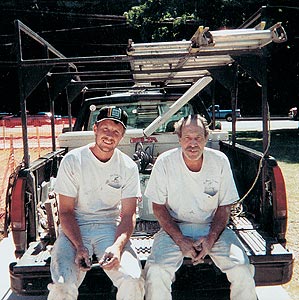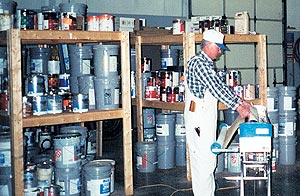
Ken Woods of Woods,
Paint Company, Inc.
Bristol, Tennessee
By Bob Graham
painting company has a simple motto: When Quality Counts. The slogan appears on everything from business cards to the five trucks that cover a 150-square-mile radius in Tennessee, Virginia, West Virginia and Kentucky. Although it's just three words, the message permeates Woods Paint Company, Inc. of Bristol, Tenn.
"We have a standard for how we do things," explains Woods, 40, a 20-year veteran. After taking drafting courses in a community college, he moved from being a part-time summer painter to a spray guy and then a foreman. "At times it seems like we're being picky, but it helps us that we try to watch the little things," Woods says.
 His business, started in 1989, and now books jobs one year in advance. His 18 employees are routinely working a total of 20 or 25 jobs at a time. Among his biggest clients is J.A. Street, a general contractor for Food City, a 100-store grocery chain in the Tri-State area that employs Woods' painters on all its construction projects. His business, started in 1989, and now books jobs one year in advance. His 18 employees are routinely working a total of 20 or 25 jobs at a time. Among his biggest clients is J.A. Street, a general contractor for Food City, a 100-store grocery chain in the Tri-State area that employs Woods' painters on all its construction projects.
When Woods' company began painting its first Food City store, he found it difficult and frustrating to use the company's paint legend because it listed different kinds of paints from different manufacturers. Woods standardized the paint legend, using Sherwin-Williams products. Company officials were so happy with his simplification that they now employ it in all their architectural plans. As a result, crews can pick up the right colors at any local Sherwin-Williams store.
"You have to do the little things well to get the business," Woods says.
Woods began to focus on those little things while working for James Booher, whose company, Booher Painting in Bristol, Tenn., was one of the largest mostly residential painting contractors in Eastern Tennessee's Tri-Cities area. In eight years working for Booher, who learned from a German-born painter, Woods developed important "patterns of work." Preparing doors, frames, or whole buildings properly was as important, if not more so, than the actual painting.
 "We learned to do a door the same way every time „ tops, sides, then bottom," recalls Woods. "You develop these patterns early in your career at a time when you don't really see the difference. But later, it helps you to be better at painting. Doing a door this way means you only squat down once, and that makes you a better painter and a healthier one." Woods moved on, taking a job as a sprayman for a commercial painting company operated by Randall Rollins, now one of Woods' four foremen. Working often in shopping malls, Woods developed the skills needed to succeed in a commercial environment. "We learned to do a door the same way every time „ tops, sides, then bottom," recalls Woods. "You develop these patterns early in your career at a time when you don't really see the difference. But later, it helps you to be better at painting. Doing a door this way means you only squat down once, and that makes you a better painter and a healthier one." Woods moved on, taking a job as a sprayman for a commercial painting company operated by Randall Rollins, now one of Woods' four foremen. Working often in shopping malls, Woods developed the skills needed to succeed in a commercial environment.
He also learned a lot about the changing nature of commercial painting. After a few years, Woods decided he wanted to set out on his own. At first, his two crews weren't as busy as Woods expected. Clients of his former employers remained loyal to them, forcing him to seek new clients.
The exercise helped Woods to crystallize his view that customer service counted the most. He worked on most of his jobs, either as part of the painting crew or in overseeing other crews.
About six years ago, Woods' responsibilities changed. He learned from a doctor that the nagging cough was asthma, a condition that would not allow him to continue painting. "I didn't know what I was going to do because I was a painter and now I was being told I couldn't do it," says Woods of what he now calls "a blessing in disguise."
He turned to running the business, not performing the work. He handled the estimating, bidding, scheduling, planning, on-site oversight, progress meetings and other administrative tasks that make or break a small business. The result was an incredible business growth, requiring him to expand to four crews.
 Woods lets his foremen handle the jobs. "I want to let them work the men and to make their own decisions, and they handle their own discipline," Woods says. "I buy them the truck and the supplies, but they have to take care of it. It's their's. I want to give a little bit of freedom to the foreman." Woods lets his foremen handle the jobs. "I want to let them work the men and to make their own decisions, and they handle their own discipline," Woods says. "I buy them the truck and the supplies, but they have to take care of it. It's their's. I want to give a little bit of freedom to the foreman."
Woods describes the ideal foreman as someone "who might not be the best painter but is someone who knows how to get the work done and can do it independently." Woods walks most jobs, checking his crews' work and pointing out the things that he's concerned about. It's where he keeps his hand in the actual work, and where he ensures that his name and reputation are preserved.
 To assist his crews, Woods standardizes what he can. Crews mostly use one brand of paints. "Better grade paints get better square footage," he notes. Caulk, spray tips and other components are in the same place in each truck. Every foreman is responsible for making sure that every brush is cleaned and wrapped in newspaper at the end of the day. "I don't want the painters losing time because their brushes aren't clean in the morning," Woods says. To assist his crews, Woods standardizes what he can. Crews mostly use one brand of paints. "Better grade paints get better square footage," he notes. Caulk, spray tips and other components are in the same place in each truck. Every foreman is responsible for making sure that every brush is cleaned and wrapped in newspaper at the end of the day. "I don't want the painters losing time because their brushes aren't clean in the morning," Woods says.
Woods finds that most painters he hires don't know how to properly clean the pumps. New employees may dislike the Woods' policy that prohibits smoking after floor tiles or wall coverings are installed. "Sometimes it costs you an employee, but if you stick to your guns, we can change a guy's bad habits," he says.
In return for their willingness to meet his standards, Woods' crews remain busy 12 months of the year. At times, his crews are too busy. They just ended a period of 14 straight Saturdays of work, all overtime.
To combat a problem that mars many commercial painting companies, Woods is a stickler for a schedule, which he uses to keep track of the four or five general contractors' jobs he's handling and planning for. A particularly large construction company in Bristol, Tennessee, sends the Woods' company all of the painting work its $25 million to $30 million in annual billings generate.
To keep on top of the process, either Woods or his general manager, Tony Woods (no relation), a six-year veteran who worked his way up in the company, keep a paper schedule. They try to stay several months ahead of the work. Typically, he obtains the general contractor's critical path sheet. It helps him figure out when his crews need to be doing their work to avoid slowing other parts of the project. "I use a light pencil because of frequent changes, but it's a start," Woods says. When backups occur, Woods shifts painters around among the jobs to keep to the project managers' schedule.
Over the last few years, he's cut his crew size from six or seven workers to three or four men. "To be successful, you have to bid more work and that means getting crews out to more places at one time," Woods says. The smaller crews are also a response to the fact that the industry is requiring quicker responses from subcontractors because jobs are increasingly being fast-tracked. "We have a lot more flexibility with the smaller crews," Woods says.
Scheduling, says Woods, is the most important part of the job, especially because so many general contractors are subcontracting so much of their work. "If you can't schedule work in the painting industry, you've had it, because everyone is counting on everyone else to do their job when they need to," Woods says.
The Woods' crews can be handling a $1,500 job painting two dentist offices during off hours or painting a factory that's on the fast track, a $150,000 job.
His experience enables Woods to look philosophically at the business.
"You need to expect the very best because that's what the customer will expect. However, expect the worst case scenario when it comes to schedules from commercial contractors because schedules never work the same and contractors are different," Woods says.
He also says painters need to find personal satisfaction in their work. "If you are looking for people to express satisfaction, you will get your feelings hurt on a daily basis. You really have to be able to get something out of it for yourself. You have to feel good about what you've accomplished each day."

|

